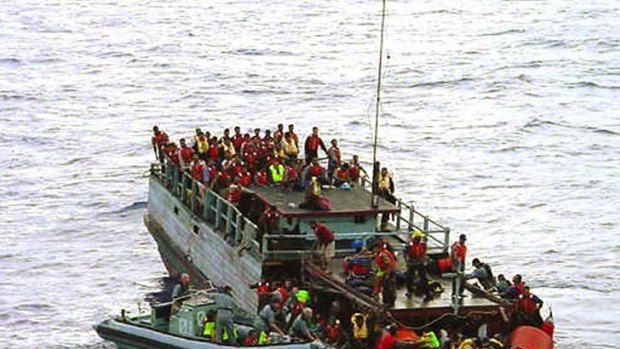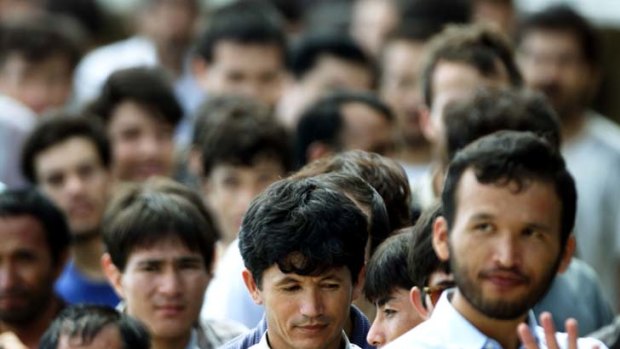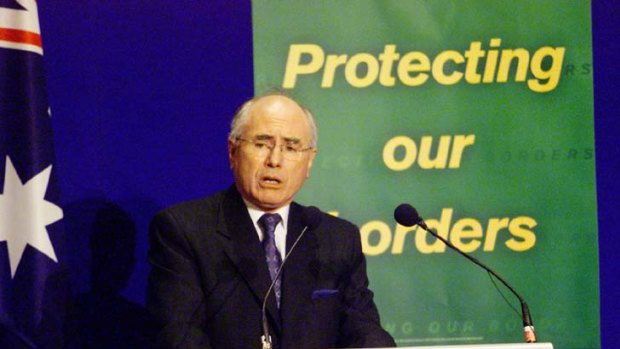By Michael Gordon
PRIME Ministers don't usually make house calls on journalists. They tend to pass by their offices on the way to the TV and radio studios of the Canberra press gallery, but they seldom drop by, leaving it to their minders to put the best possible spin on the day's events.
August 29, 2001, was different. Aside from being the day Bob Hawke became the first Labor prime minister to be voted out of office by his caucus, and the day Kevin Rudd suffered the same fate, it was the most dramatic 24 hours in Australian politics since Malcolm Fraser called the 1983 election.

Australian navy personnel rescue asylum-seekers from a sinking boat off Christmas Island in 2001. The Howard Government later falsely claimed the refugees had thrown children overboard. The Age has tracked down an interviewed asylum seekers involved with the Tampa. Their stories are on this page.Credit: Reuters
It began when Arne Rinnan, the veteran captain of the Norwegian freighter Tampa, defied orders from Canberra to stay away from Australian waters with his cargo of 433 rescued asylum seekers, many of them in urgent need of medical attention, and proceeded towards Christmas Island, the tiny Australian territory that sits below Java.
It ended, after heavily armed SAS troops seized control of the ship, with John Howard introducing retrospective legislation giving his government the power to remove the Tampa, and any similarly unwelcome vessels in the future, irrespective of the circumstances or the consequences.

The asylum seekers.Credit: Angela Wylie
Having supported the government from the moment the crisis broke two days earlier - insisting the last thing the situation needed was a ''carping opposition'' - Labor leader Kim Beazley then took the decision to oppose the new law, knowing full well that it might cost him the election that was soon to be called. Accusing Howard of ''wedge politics'', Beazley said in Parliament: ''Whatever particular political advantage you think it gives you, we will not be in it.''
It was after the legislation was defeated in the Senate, on the votes of Labor, the minor parties and independents (though subsequent border protection legislation was passed with Labor's support) that Howard made a rare, late-night visit to the press gallery. Reporters from The Australian later described how the prime minister strode into their office ''bristling with nervous energy'', his eyes bulging, his face reddened, and appearing to be operating on pure adrenalin. The message was as emphatic as it was succinct. ''That boat will never land in our waters - never!'' he declared. Implicit was a determination that those on board the Tampa would never set foot on Australian soil, either.
The Pacific Solution was cobbled together in the days and weeks that followed, but Howard had embarked on a course from which there would be no deviation. One act of humanity by a Norwegian seaman had given him the opportunity to draw a line in the sand. As one cabinet minister told me: ''They're not in a leaky boat that was sinking. They're in a 60,000-tonne container ship and their lives are not in danger.''
In the days that followed, the other defining elements of the policy were put into place: islands were excised from the Australian migration zone to prevent asylum seekers lodging visa applications; detention centres were set up on Papua New Guinea's Manus Island and the tiny and bankrupt republic of Nauru; and a reluctant Navy was engaged to intercept and turn back vessels containing asylum seekers.

Talking tough, John Howard.Credit: Mike Bowers
Against the backdrop of a legal challenge that was defeated on appeal, international condemnation and a breakdown in relations with Indonesia, the fortunes of a government were transformed. Midway through August, the polls had Labor just in front. According to the ALP national secretary of the time, Geoff Walsh: ''Tampa restored a massive 10 per cent to the Liberal Party primary vote.''
Howard has since argued that the Coalition would have won the November 10 election without the Tampa episode or the 9/11 attacks on New York and Washington that followed. Social researcher Hugh Mackay disagrees, asserting that Tampa was decisive. The month before the ship was intercepted, Mackay was conducting focus group research for his annual snapshot of the nation's mind and mood. ''Some of the most ugly and vicious outpourings of hatred occurred in discussion of boat people,'' he reported.
Within four months of Tampa, the boats stopped coming, but not before asylum seekers were wrongly accused by the Prime Minister of throwing their children into the water, more than 350 people perished when their boat capsized and many more were taken to offshore detention centres.
IN HIS memoirs, Howard describes the response to the Tampa as a ''resounding success''. The number of unauthorised arrivals by sea dropped from 5516 in 2001 to precisely one in 2002. ''We had regained control over our border protection processes … and the Australian people were in full support of our actions.'' But a price was paid. Australia, with a proud record as a model international citizen, had made the harshest system for dealing with asylum seekers in the developed world a whole lot tougher. ''What makes Australia's detention system so invidious is that it combines the three elements of being mandatory, indefinite and non-reviewable,'' the UN High Commissioner for Refugees then representative in Australia, Michel Gabaudan, told me at the time. ''This, in our view, makes it the most severe system to be found in the Western democratic world.'' Among those who agreed was Paris Aristotle, a senior member of the government's detention advisory group, who believed that elements of the approach would eventually be seen in the same way as the forced removal of indigenous children from their families.
''If you took the characteristics of dispossession, separation, isolation, trauma, complete lack of power over your lives and a lack of judicial redress, all of those elements exist in how we are dealing with this at this point of time,'' Aristotle, who remains director of the Victorian Foundation for Survivors of Torture, told The Age in 2002. They still exist today.
Professor Harry Minas, another member of the advisory group, concurred. ''I think in a few years we will seriously be wondering what the hell we were doing and what the hell were we thinking,'' he said.
Minas's dismay that nothing has changed is profound. ''There is a paradox at the heart of Australia's asylum seeker policy,'' he told The Saturday Age yesterday. ''Government regularly solicits expert external advice on crisis management and on the ongoing pernicious consequences of failed, harmful and wasteful policy, but government refuses to accept consensus expert advice that could prevent the recurrent crises that result from bad policy.
''Ten years after the Tampa crisis, Australia still has prolonged detention, even after health, identity and security checks have been completed. Both the government and opposition have committed to resume third-country processing. This is a lamentable national regression. The damage inflicted in August 2001 by Coalition opportunism and Labor weakness has yet to run its course.''
Herein lies the real tragedy of the Tampa. A decade on, both sides of politics are, once again, seeing asylum seeker policy solely through the prism of the message sent to the people smugglers. A collective amnesia seems to have taken hold in some quarters about what really happened during those first frenetic months - and the long years that many endured in hopeless isolation on Nauru.
Some who vehemently opposed the Pacific Solution have recently asserted that sending unauthorised arrivals to Nauru is morally superior to the Gillard government's alternative of sending boat arrivals to ''the back of the queue'' in Malaysia and, in return, taking more refugees who have languished in that country for years.
''In Nauru, at least the Australian government was providing healthcare and education,'' respected Jesuit priest Father Frank Brennan said recently. ''And, most significantly, once someone was proved to be a refugee in Nauru they would be guaranteed resettlement.''
Brennan was among many social justice advocates, lawyers and journalists who tried and failed to see first hand what was happening on Nauru. Had he been issued with a visa, he would have discovered that his assertion about healthcare is extremely problematic and that his understanding of refugee determination and resettlement on Nauru is just plain wrong.
By the time the Tampa asylum seekers were persuaded to board the troopship HMAS Manoora - having been shown large pictures of a cooked chicken, a clean bathroom, and a bed - many had not eaten or showered for 12 days. From the moment they were on the Manoora, the pressure to return to Afghanistan was intense.
MUSTAFA Najib, 32, is one of fewer than 30 who were rescued by the Tampa who were ultimately afforded protection in Australia. Ask him about it now and the first reaction is a smile at the memory of ''happy feelings'' that he was not going to die.
''If you've watched Titanic, there were those guys playing their music as if nothing is wrong as the boat went down. That's the feeling we had during those four days before we were rescued,'' he explains. ''You accepted that you will drown, and then suddenly there is some hope that you will be rescued and that becomes a reality. It took a while to get past that happiness …''
Najib, the second-eldest of eight siblings, was found to be a genuine refugee, but he spent two years on Nauru, including more than 12 months awaiting resettlement after his claim for protection was accepted as valid. ''For a whole year they were not doing anything,'' he says. ''Although I and some others were given refugee status, some 400 or 500 others who were working hard to prove their claims would look at us and say, 'What's the point! They've proven their claims but they're still here'.''
During this period, the asylum seekers were not assigned case workers and had no contact with lawyers who could help them. ''All that happened was that, every two or three months, three or four officials would grab a loud speaker and tell hundreds of people, 'If you want to go back, there is a repatriation package. Afghanistan is safe, go back.' ''
As the numbers on Nauru increased, so too did the severity of the policy. Those women and children whose husbands were already in Australia on temporary protection visas, after being found to be refugees, were told they would never be allowed to enter Australia and should go back to Afghanistan or Iraq. In the end, New Zealand, the country that offered sanctuary to 208 of those on the Tampa, came to their rescue.
Those who came by boat after passing through a country where they could have lodged a protection claim were told they could never have permanent protection or be reunited with immediate family.
As Najib puts it: ''I think that, if Nauru worked as a measure to stop boats, it is because people were very clearly told: 'Don't even bother. We're not a humanitarian country. We will send you back.' It doesn't matter who you are or what your situation is.''
While many gave up in despair and returned to Afghanistan, the punishment for those who resisted the pressure did not end when they arrived in Australia. Najib arrived in Melbourne late in 2003 on a five-year temporary protection visa.
This meant seven years in limbo and no right to permanency, limited support, no capacity to travel and no prospect of being reunited with his younger siblings who depended totally on him for support.
Even so, with help from people like his Australian ''mum'', Halinka Rubin (who wrote to him while he was on Nauru), Afghans who were already here, and a scholarship from the RMIT University, Najib worked two jobs and secured a diploma in interpreting and a degree in international studies before being invited to complete a master's degree in arts at Monash.
Najib nows works with the Red Cross, helping those who have been approved to move from detention centres into community accommodation. Ironically, he has even been to Christmas Island, having been flown there to assist the passage of a group who had been issued with permanent protection. One of his younger brothers, Hashmat, 17, is here as an international student to complete secondary school, sponsored by Najib.
Najib will not be in Australia for the 10th anniversary of the Tampa next weekend, he will be in Washington, having been invited by the US consulate-general Melbourne to be part of the International Visitor Leadership Program.
Hugh Mackay says the potential remains for the politics of asylum seekers to change. ''I still have faith in the idea that when politicians appeal to the noble side of our natures, rather than the darker side, we will respond.''
As Mustafa Najib points out, a willingness to treat uninvited arrivals with more compassion could pay a bigger dividend than we imagine. ''Today I am an educated person. I am helping my family and other people [in Afghanistan] and I am really keen to do that,'' he explains. ''And that's the connection we need to have for a better world, you know? The reason Afghanistan is a problem for the whole world is because of a lack of education, because of a lack of this connection and this massive misunderstanding about the West in Afghanistan, and a massive misunderstanding about Afghanistan here. What we need is that better connection.''
Until the penny drops, three words describe the distance travelled since Tampa: we've gone nowhere.